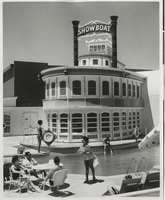Search the Special Collections and Archives Portal
Search Results

Photograph of the front of El Rancho Vegas (Las Vegas), 1950s
Date
Archival Collection
Description
The front of the El Rancho Vegas with a woman in a bikini. Stamp on back of photo: "Please credit Union Pacific Railroad Photo."
Site Name: El Rancho Vegas
Address: 2500 Las Vegas Boulevard South
Image

Photograph of the Flamingo Hotel pool and courtyard (Las Vegas), 1950s
Date
Archival Collection
Description
View of the pool and courtyard area of the Flamingo Hotel. Stamp on back of photo: "Please credit Union Pacific Railroad Photo, Public Relations Department, 422 West 6th St., Los Angeles 14, Calif, File Print Stock, Los Angeles Neg."
Site Name: Flamingo Hotel and Casino
Address: 3555 Las Vegas Boulevard South
Image

Photograph of the front of the Flamingo Hotel (Las Vegas), 1950s
Date
Archival Collection
Description
View of the Flamingo Hotel and Casino, including a full parking lot. The Champagne Tower is seen on the right. Stamped on original: "Please credit Union Pacific Railroad Photo, Public Relations Department, 422 West 6th St., Los Angeles 14, Calif, File Print Stock, Los Angeles Neg."
Site Name: Flamingo Hotel and Casino
Address: 3555 Las Vegas Boulevard South
Image

Photograph of two women near the front entrance of the Thunderbird Hotel (Las Vegas), circa 1950s
Date
Archival Collection
Description
Entrance of the Thunderbird Hotel showing the porte-cochère and the marquee. Stamped on original: "Please credit Union Pacific Railroad Photo."
Site Name: Thunderbird Hotel
Address: 2755 Las Vegas Boulevard South
Image

Photograph of a parade on Fremont Street (Las Vegas), 1956
Date
Archival Collection
Description
Parade on Fremont Street showing views of the façades of the Pioneer Club, California Club and others. Stamped on original: "Please credit Union Pacific Railroad Photo, Public Relations Department, 422 West 6th St., Los Angeles 14, Calif, File Print Stock, Los Angeles Neg."
Site Name: Fremont Street
Address: Fremont street, Las Vegas, NV
Image

Photograph of the Showboat Hotel and Casino (Las Vegas), 1950s
Date
Archival Collection
Description
The swimming pool at the Showboat. Stamped on original: "Please credit Union Pacific Railroad Photo, Public Relations Department, 422 West 6th St., Los Angeles 14, Calif, File Print Stock, Los Angeles Neg."
Site Name: Showboat Hotel and Casino
Address: 2800 East Fremont Street
Image

Photograph of the Riviera Hotel exterior (Las Vegas), circa 1950s
Date
Archival Collection
Description
The Rivera Hotel, shortly after it opened. Stamped on original: "Please credit Union Pacific Railroad Photo, Public Relations Department, 422 West 6th St., Los Angeles 14, Calif, File Print Stock, Los Angeles Neg."
Site Name: Riviera Hotel and Casino
Address: 2901 Las Vegas Boulevard South
Image

Photograph of the swimming pool at the Sands Hotel (Las Vegas), 1950s
Date
Archival Collection
Description
Hotel guests enjoying the swimming pool in the courtyard of the Sands. Stamped on original: "Please credit Union Pacific Railroad Photo, Public Relations Department, 422 West 6th St., Los Angeles 14, Calif, File Print Stock, Los Angeles Neg."
Site Name: Sands Hotel
Address: 3355 Las Vegas Boulevard South
Image

Photograph of the façade of the Moulin Rouge Hotel (Las Vegas), 1955
Date
Archival Collection
Description
Façade, tower, and sign of the Moulin Rouge Hotel. Stamp on back of photo: "Please credit Union Pacific Railroad Photo, Public Relations Department, 422 West 6th St., Los Angeles 14, Calif, File Print Stock, Los Angeles Neg."
Site Name: Moulin Rouge Hotel
Address: 900 West Bonanza Road, Las Vegas, NV
Image

Photograph of the swimming pool at the Dunes Hotel (Las Vegas), circa 1950s
Date
Archival Collection
Description
Guests enjoying the swimming pool at the Dunes Hotel.
Site Name: Dunes Hotel
Address: 3650 Las Vegas Boulevard South, Las Vegas, NV
Image
